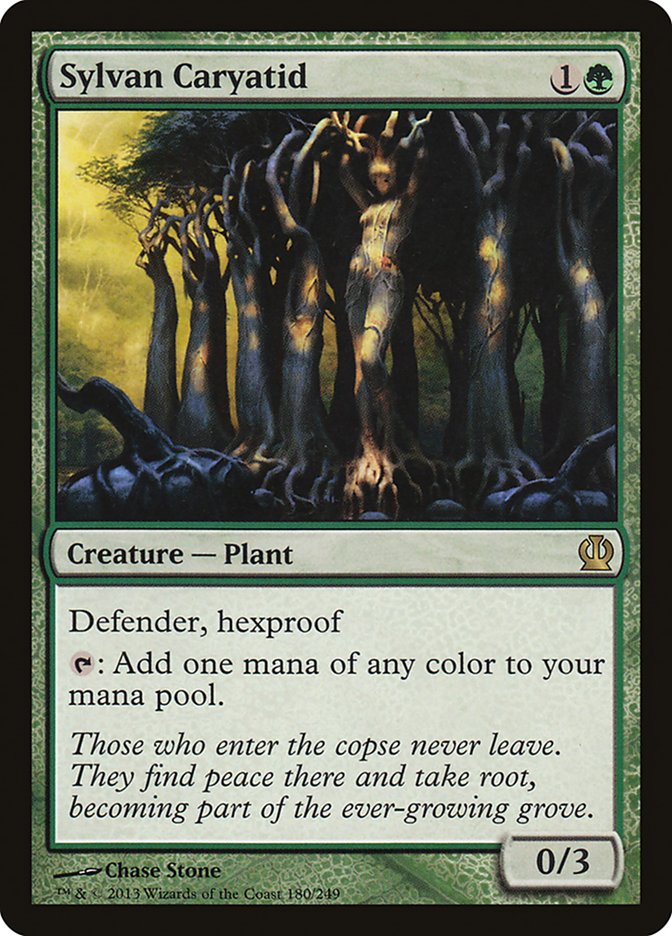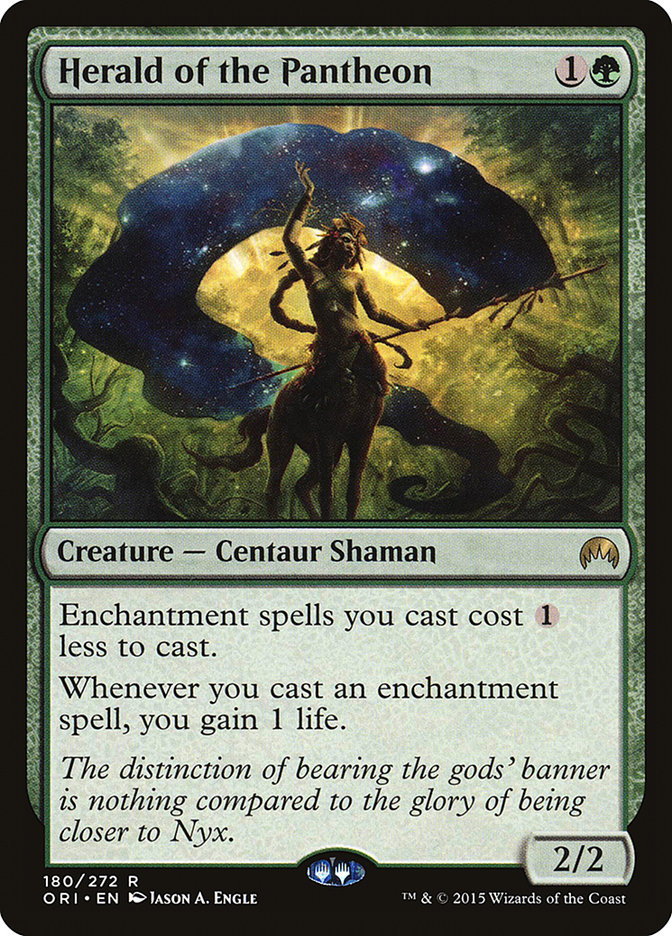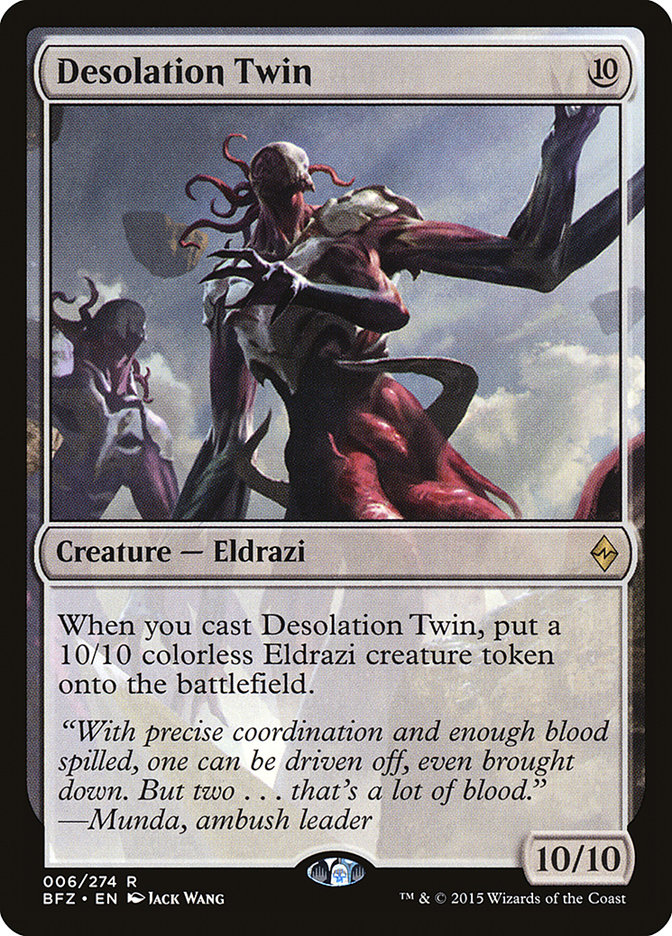For a long time, green was one of the weakest colors in Magic. Before the paradigm of creatures being the most powerful spells in Magic, green struggled to
stay relevant amongst efficient red and black removal spells, blue’s disruptive shenanigans, and white’s ability to undo turns of work with a single,
efficient Wrath of God. Green had it rough; they had the biggest creatures on the block, but you had to untap with them to have an impact. Green might have
been a splash in the best decks, but the backbone of the format rarely relied on Forests.
Over the last two years, though, green has surged to the forefront, primarily on the back of three specific cards.
These creatures have afforded green the opportunity to rise above mediocrity and make a lasting, permanent impact on Standard. For me, I know I cringe if I
see a Elvish Mystic on turn 1 and I don’t have a removal spell. Sylvan Caryatid, while innocuous, often hints at Abzan Midrange, a deck I’m personally sick
and tired of playing against. Courser of Kruphix is a great value engine, giving green legitimate card, life, and board advantage while blocking aggressive
starts from most any color. But these creatures share one thing in common.
They’ll all be gone in less than a month.
With the shift of Standard away from an environment of grindy life swaps and fast, Nykthos, Shrine to Nyx ramp games, what’s going to be left? What will
green become after these three critters bow out?
As I take a guess on what the future of green will be, let’s look at each card, see what its absence facilitates, and then brainstorm a rough deck that can
fill the metagame vacuum.
What started as a $2.99 card inflated to be one of the chase rares of the format; a bit of brewing with this sparkly centaur proved what a gem it was for
the green decks against those aggressive matches. It grabbed hold and never let go, blocking Goblin Rabblemaster tokens and undoing Thoughtseize life loss
for months and months. Without it, though, we get to see the resurgence of aggro. True, aggro wasn’t really dead, but every aggressive player had to ask
him or herself, “Can I beat a resolved Courser?” With that question nullified, removal is a little less important. That opens up its own color’s quietest
archetype.
Creatures (24)
- 2 Den Protector
- 4 Avatar of the Resolute
- 4 Servant of the Scale
- 2 Honored Hierarch
- 4 Hangarback Walker
- 4 Undergrowth Champion
- 4 Scythe Leopard
Lands (24)
Spells (12)

Good one-drops have become increasingly rare, and removal is also becoming more conditional and more expensive. With this in mind, you can eschew removal
entirely and play the cheapest, fastest bruisers, just like green was born to do.
This first brew has a significant counter subtheme; nearly every card gains +1/+1 counters either off a trigger or simply by being cast. Hardened Scales’
rock-bottom casting cost begs you to get it out early so you can start moving your creatures out of burn and blocking range. For this deck, Honored
Hierarch is the ideal turn 1 play, with a turn 2 Hardened Scales to make him a 3/3 vigilance post-combat, with a strong four-mana follow up on the next
turn. Having a mana creature allows you to save your lands for the landfall creatures who need them to be relevant. Servant of the Scale is an automatic
2/2 with Hardened Scales, and when it dies, you’ll get an extra counter on its trigger’s target. This may not seem like a big deal, but it costs you just
one mana and requires no further investment. Undergrowth Champion is one of Battle for Zendikar‘s most exciting mythics, providing green aggro the
punch and durability it needs to stay the course. Free power and toughness boosts is what makes Tarmogoyf such a staple in Modern, and Undergrowth Champion
feels a bit like it. I mean, it gets bigger for you just playing the game. Hangarback Walker, which I predict will only get bigger and better as the format
changes, also has +1/+1 synergy and, as you’ll likely have extra mana every turn, it can get bigger and provide your green deck some needed evasion when it
dies. Scythe Leopard might seem a little weak, but every fetchland you play per turn makes this Cat a 3/3. There was another 3/3 one-drop that was so good it was banned in Modern for a while, so
I’ll take notice when something like Scythe Leopard shows up in Standard. Den Protector, good as always, also gains a +1/+1 counter when it megamorphs, and
the more +1/+1 counters you can get on it, the more evasive it gets.
In the spell territory, Dromoka’s Command acts as removal, a +1/+1 counter generator, and way to protect you from the errant one-mana red spells that will
still be Standard legal after rotation. Atarka’s Command can give a scrawny team a boost, and it can provide instant-speed landfall in addition, a
potentially critical mid-combat boost. You can attack on turn 2 with a Scythe Leopard, play a fetchland and crack it, cast Atarka’s Command, using the
three damage/play a land mode to play another fetchland, and crack that one to deal eight damage on turn 2. And it only cost you one
card! With all these lands going to the graveyard, Become Immense is an easy spell to cast. Target Den Protector or Avatar of the Resolute for maximum
damage! Hardened Scales is great, but you only really need one to be reasonably efficient. Retreat to Kazandu, one of the first spoiled cards of the set,
gives a Lifegift style effect or it can pump your team. The option to choose when each land enters the battlefield is really important. Similarly,
it’s fine if one’s on the battlefield, but you’d likely rather have a creature than a second, third, or fourth one.
24 lands is a lot for a deck full of ones and twos, but you want to have lots of basic lands, lots of fetchlands, and some of the new Battle lands, e.g.
Canopy Vista and Cinder Glade. They’re almost little spells. Remember how every deck in Zendikar Limited played eighteen lands? I feel like
that’ll probably be true again, to some degree.
Now that aggro’s covered, what about fixing?
Sylvan Caryatid was a mainstay of Abzan Midrange since Siege Rhino became the most efficient creature in Standard. Is there any hope for the deck
post-rotation, especially with the loss of Courser of Kruphix?
Much as I hate to say it, you bet!
Let’s look at Abzan Midrange with a returning casual favorite: Felidar Sovereign!
Creatures (27)
- 2 Felidar Sovereign
- 4 Anafenza, the Foremost
- 4 Siege Rhino
- 4 Whisperer of the Wilds
- 4 Den Protector
- 4 Hangarback Walker
- 4 Lantern Scout
- 1 Tajuru Warcaller
Planeswalkers (4)
Lands (25)
Spells (4)

This Abzan deck looks a little different, huh? Without Thoughtseize or Sylvan Caryatid, you have the flexibility to move in a variety of directions
colorwise. The deck is, again, for illustrative purposes and is likely not viable, but the point is that Abzan is more like the other Khans clans; you can
have a core of any one color or you can splash around a bit. Little did you know Sylvan Caryatid was restrictive, requiring you to hit your on-time mana
ramp to get to a Rhino. Now, you just play the powerful cards you’re fixing for and you can do it in most any order you please. As a side note, casting
Ruinous Path with Awaken on turn 4, powered by a turn 2 Whisperer of the Wilds, turn 3 Siege Rhino, is an amazing feeling.
So that leaves Elvish Mystic.
[Image:
Without a turn 1 mana creature, how are you supposed to cast those big, big spells?
Don’t worry. We gotcha.
This guy might seem silly, but he is effectively a mana creature if your enchantment count is high enough, and with some powerful, mana-oriented
enchantments that won’t rotate and some that will arrive with Battle for Zendikar, we can make a ramp deck that doesn’t need any of the
traditional players to cast the most exciting spells from the new set: Eldrazi.
Creatures (17)
- 2 Shaman of Forgotten Ways
- 2 Nissa, Vastwood Seer
- 3 Herald of the Pantheon
- 3 Oblivion Sower
- 1 Ulamog, the Ceaseless Hunger
- 2 Desolation Twin
- 3 Conduit of Ruin
- 1 Void Winnower
Lands (25)
Spells (18)

Very, very rough, but I think that more cards being spoiled will make this a little less janky.
This deck centers on the new enchantment From Beyond, a revised version of the Rise of the Eldrazi spell Awakening Zone. This does everything we
want, from making creatures to block or provide mana to finding the Eldrazi we want once we’re ready to end the world. As a cute interaction, I splashed
red to include Outpost Siege–both because of its draw potential and also because of its Dragons mode where you can develop an army of Eldrazi Scions then
sacrifice them all to clear the board of blockers or aim for the face to finish the game. If you need to, you can sandbag those tokens, then activate
Shaman of Forgotten Way’s formidable ability to imitate Biorhythm. You can’t lose!
Regarding the Eldrazi, I know everyone’s excited about Ulamog, the Ceaseless Hunger, but I think my favorite Eldrazi are the ones that are nonlegendary.
Desolation Twin is perhaps my favorite; people have been bashing it, saying that Ulamog is just better, and while it normally is because it exiles
permanents (which is really good), Desolation Twin threatens lethal on nearly any board. If they have no blockers, they’re dead. Not take
half your life and lose half your library, you’re just dead. Also, folks likely have the answer to one permanent, albeit an indestructible one,
but Desolation Twin is not so easily thwarted. Probably just the Timmy in me.
All three of these decks were hastily assembled to keep up the with the newest ring of spoilers, but thankfully, the next few days will be full of new
cards that will only bolster the decks listed here and the countless other brews floating around in your heads. Moreover, these are here to prove a point:
green will be drastically different.
How are you
celebrating
adjusting with the passing of these three green enablers? What archetypes do you think are open both because of the loss of Theros block and Magic 2015 and because of Battle for Zendikar?





